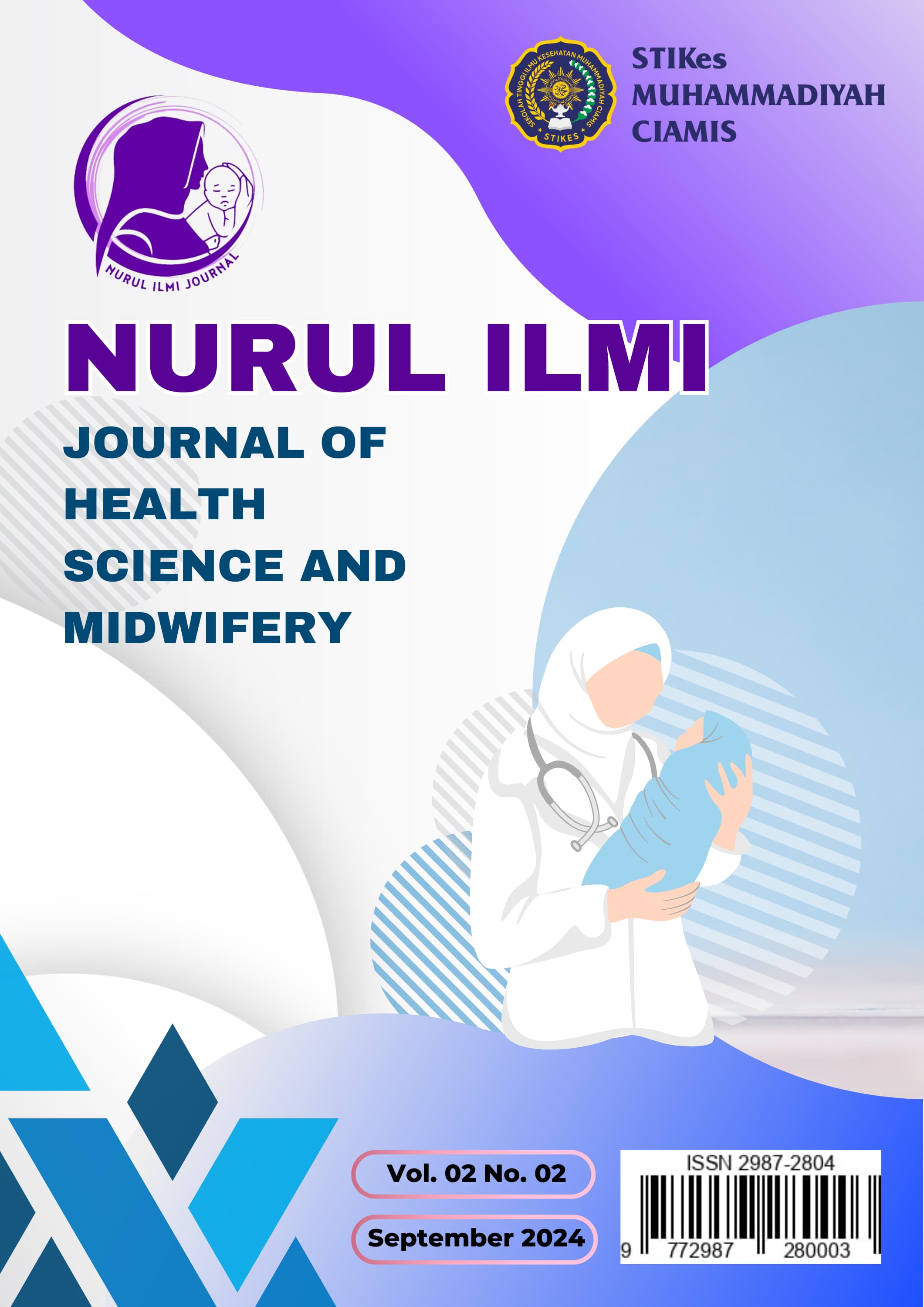Literature Review: Factors Risks that Influence the Incidence of Stunting
DOI:
https://doi.org/10.52221/nuri.v2i2.730Keywords:
factors, risks, stuntingAbstract
Introduction: Stunting is associated with impaired growth and development in children. In the short term, it can cause problems such as: an upward trend in the morbidity and mortality rate of children, decreased intelligence, motor disorders, increased spending on health, and increased costs for health care and disease treatment. Meanwhile, in the long term, they include decreased height in adult children, decreased reproductive health, low activity at school, less potential learning capacity, and low work capacity and productivity. Objective: The purpose of this research is to review the literature, articles, and results documents of research on factors that influence the incidence of stunting. Method: The method used in writing this article is a review of the results of a study the research on factors that influence the incidence of stunting. The type of data in this literature review study were obtained by tracing scientific research articles from 2022-2024 using a data base such as Pubmed, google schoolar. Result: Many kinds of the risks to related the stunting. There are associated with stunting, namely residence, age of mother, mother’s education, mother’s occupation, economic status, child’s age, gender, EBFI, having no access to safe drinking water, not proper sanitation, and poor maternal hygiene practices. The other the risks to related the stunting were marital status, before pregnancy, during pregnancy, postnatal, infectious disease factors and socia-demographic factors. Conclusion: This review concluced that average risks to related the stunting were maternal age, maternal education, recidence, employement, child’s age, gender, economic status.
References
Agussalim, Zulkifli, A., Nasry Noor, N., Ansariadi, Stang, & Riskiyani, S. (2024). Risk Factor Analysis of Stunting in Children Aged 6-23 Months in Tanralili District, Maros Regency, Indonesia. National Journal of Community Medicine, 15(7), 559–565. https://doi.org/10.55489/njcm.150720244014
Ashar, H., Laksono, A. D., Supadmi, S., Kusumawardani, H. D., Yunitawati, D., Purwoko, S., & Khairunnisa, M. (2024). Factors related to stunting in children under 2 years old in the Papua, Indonesia Does the type of residence matter? Saudi Medical Journal, 45(3), 273–278. https://doi.org/10.15537/smj.2024.45.3.20230774
Fagbamigbe AF, Kandala NB, U. A. (2020). Demystifying the factors associated with rural-urban gaps in severe acute malnutrition among under-five children in low- and middle-income countries: a decomposition analysis. 10, 1–15.
Gusnedi G, Nindrea RD, Purnakarya I, Umar HB, Andrafikar, S. et al. (2023). Risk factors associated with childhood stunting in Indonesia: A systematic review and meta-analysis. Asia Pac J Clin Nutr, 32, 184–195.
Juwita S, Andayani H, Bakhtiar, Sofia, A. (2019). The Relationship between Total Family Income and Completeness of Basic Immunization with the Incidence of Stunting in Toddlers in Pidie Regency. Jurnal Kedokteran Nanggroe Medika, 2(4)1-10.
Khan S, Zaheer S, S. N. (2019). Determinants of stunting, underweight and wasting among children < 5 years of age: Evidence from 2012-2013 Pakistan demographic and helath survey. BMC Public Helath, 19, 1–16.
Kusumawardani, H. D., Laksono, A. D., Hidayat, T., Supadmi, S., Latifah, L., Sulasmi, S., Ashar, H., & Musoddaq, M. A. (2023). Stunting Among Children Under Two Years in the Islands Areas: A Cross-sectional Study of the Maluku Region in Indonesia, 2021. Journal of Research in Health Sciences, 23(4), e00597–e00597. https://doi.org/10.34172/jrhs.2023.132
Laksono, A. D., Sukoco, N. E. W., Rachmawati, T., & Wulandari, R. D. (2022). Factors Related to Stunting Incidence in Toddlers with Working Mothers in Indonesia. International Journal of Environmental Research and Public Health, 19(17). https://doi.org/10.3390/ijerph191710654
Marfuah D, Pertiwi D, Kusudaryati D, K. N. (2022). The Difference from Mother’s Education, Mother’s Occupation and History of Providing Weaning Food in Stunting and Non Stunting Toddlers in the Trucuk II Public Health Center Klaten. LPPM PTMA, 292–305. https://repository.urecol.org/index.php/proceeding/article/v%0Aiew/2445
Mediani, H. S. (2022). Factors Affecting the Knowledge and Motivation of Health Cadres in Stunting Prevention Among Children in Indonesia. April.
Modjadji P. (2021). Engaging mothers on the growth of school-age children in a rural South African health and demographic site: a qualitative insight. Healthcare (Basel), 9(2):225. 10.3390/healthcare9020225
Modjadji P, M. J. (2020). Persistent malnutrition and associated factors among children under five years attending primary health care facilities in Limpopo province, South Africa. Int J Environ Res Public Health, 17(20):758. 10.3390/%0Aijerph17207580
Mustakim, M. R. D., Irwanto, Irawan, R., Irmawati, M., & Setyoboedi, B. (2022). Impact of Stunting on Development of Children between 1-3 Years of Age. Ethiopian Journal of Health Sciences, 32(3), 569–578. https://doi.org/10.4314/ejhs.v32i3.13
Novianti, S., Huriyati, E., & Padmawati, R. S. (2023). Safe Drinking Water, Sanitation and Mother’s Hygiene Practice as Stunting Risk Factors: A Case Control Study in a Rural Area of Ciawi Sub-district, Tasikmalaya District, West Java, Indonesia. Ethiopian Journal of Health Sciences, 33(6), 935–944. https://doi.org/10.4314/ejhs.v33i6.3
Suyanto, S., Wahyuni, S., Zulharman, Z., Restila, R., Irfansya, R., Aprillianty, E. N., & Adraf, N. W. (2024). Understanding stunting risk factors in Kampar Regency: Insights from mothers with stunted children (qualitative study). SAGE Open Medicine, 12(1). https://doi.org/10.1177/20503121241244662
Downloads
Published
How to Cite
Issue
Section
License
Copyright (c) 2024 Dini Ariani, Hani Septiani , Yanti Srinayanti, Rosidah Solihah

This work is licensed under a Creative Commons Attribution 4.0 International License.













